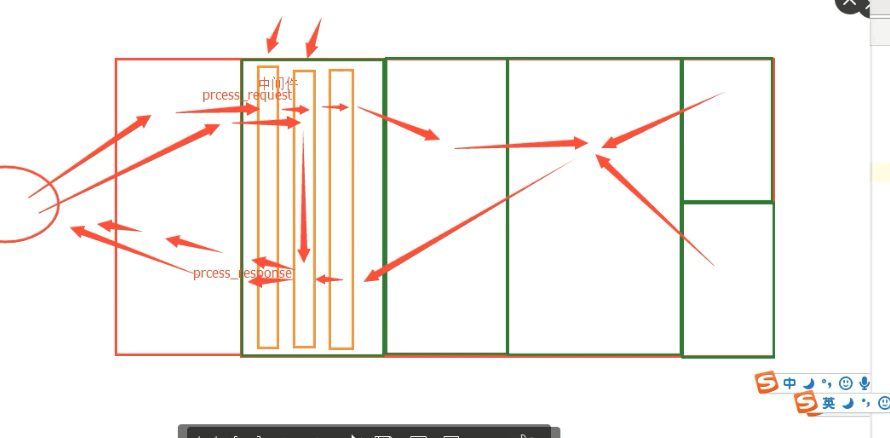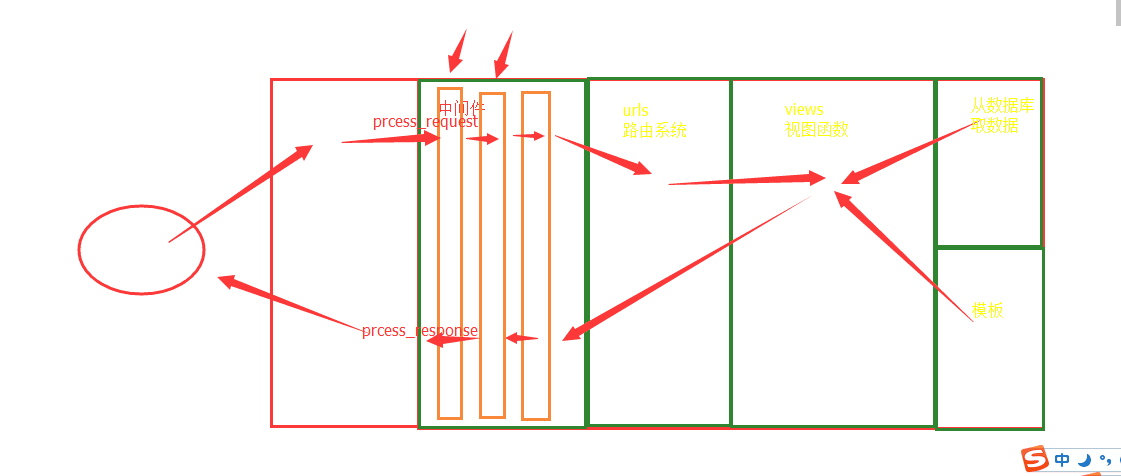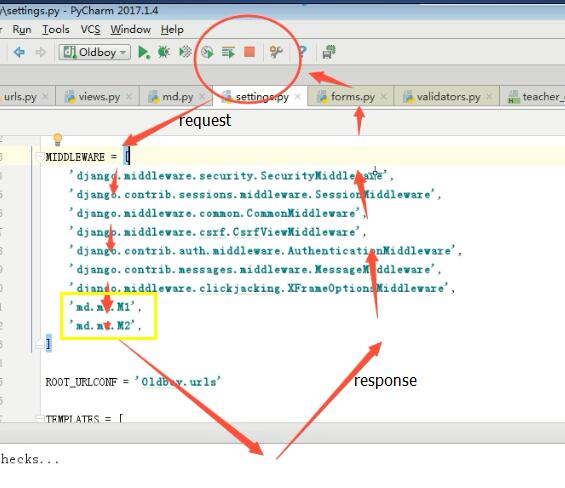自定义验证规则以及中间件简单介绍
1、python2和python3中的区别
对于python2内置的字符串类型有str和unicode 比如:"abc"是字符串,u"你好"是unicode 字符串(utf-8/gbk编码之后值) unicode
对于python3内置的字符串类型有bytes和unicode bytes(utf-8/gbk编码之后值) 字符串(unicode) python3 中的bytes,就是python2中的字符串 python2 中的字符串,就是python3中的unicode
2、数据源无法时时更新,有两种方法
方式一:重构构造方法(推荐)
方法一:重构构造方法(推荐)
class ClassesForm(Form):
name = fields.CharField(
required=True, # 必填字段
error_messages={"required": "姓名不能为空!!"}, # 显示中文错误提示
widget=widgets.TextInput(attrs={"placeholder": "姓名", "class": "form-control"}), # 自动生成input框
)
# 如果直接定义成classteacher_id,,_id 的形式,这样你添加数据的时候不会时时更新,所以在下面定义一个重写的方法
# classteacher_id = fields.ChoiceField(choices= models.UserInfo.objects.filter(ut_id = settings.ROLE_CLASSTEACHER).values_list('id', "username"))
classteacher_id = fields.ChoiceField(choices=[])
def __init__(self,*args,**kwargs): #重写init方法,时时更新
super().__init__(*args,**kwargs) #继承父类
self.fields["classteacher_id"].choices = models.UserInfo.objects.filter(ut_id = settings.ROLE_CLASSTEACHER).values_list('id', "username")
注意:
要是这样:fields.ChoiceField(choices=[])
注意choices里面传[(1,"讲师"),(2,"班主任"),(3,"管理员")]所以数据库里取的时候得用values_list
方式二:
方法二:ModelChoiceField(不推荐),queryset
from django.forms.models import ModelChoiceField #先导入
class ClassForm(Form):
caption = fields.CharField(error_messages={'required':'班级名称不能为空'})
# headmaster = fields.ChoiceField(choices=[(1,'娜娜',)])
headmaster_id = ModelChoiceField(queryset=models.UserInfo.objects.filter(ut_id=2))
3、Form基本使用
类
字段
is_valid()
cleaned_data
errors
字段参数:
max_length
min_length
validators = [RegexValidators("xxx")]
钩子函数
clean_字段名
注意:
必须有返回值
只能拿自己当前字段值
raise ValidationError("xxx")
下拉框数据源时时更新
1、重写init方法
先执行父类构造方法
self.fields["xx"].choices = xxxxx
2、ModelChoiceField
4、用户登录
- form的字段可以定义正则表达式
password = fields.CharField(
required=True,
min_length=3,
max_length=18,
error_messages={
'required': '密码不能为空',
'min_length': '密码长度不能小于3',
'max_length': '密码长度不能大于18',
'invalid': '密码格式错误',
},
validators=[RegexValidator('d+','只能是数字') ]
)
注意:error_messages的优先级比validators高
需要导入的模块
from django.forms import Form from django.forms import fields from django.forms import widgets from django.conf import settings from django.core.validators import ValidationError from django.core.validators import RegexValidator
class LoginForm(Form):
username = fields.CharField(
required=True, #必填字段
min_length=3,
max_length=16,
error_messages={
"required":"用户名不能为空",
"min_length":"长度不能小于3",
"max_length":"长度不能大于16"
},
widget=widgets.TextInput({"placeholder":"username","class":"form-control"})
)
password = fields.CharField(
required=True,
min_length=3,
max_length=16,
error_messages={
"required": "密码不能为空",
"min_length": "密码长度不能小于3",
"max_length": "密码长度不能大于16",
# "invalid":"密码格式错误"
# error_messages的优先级高,如果写上"invalid":"密码格式错误"这个就会优先显示这个错误
},
widget=widgets.PasswordInput({"placeholder":"password","class":"form-control"}),
validators=[RegexValidator("d+","密码只能是数字")] #可以进行正则匹配提示错误
)
def clean_username(self):
user = self.cleaned_data["username"]
is_exits = models.UserInfo.objects.filter(username=user).count()
if not is_exits:
raise ValidationError("用户名和密码错误")
return user #必须有return
views.py ---------login
def login(request):
if request.method == "GET":
form = LoginForm()
return render(request, "login.html", {"form": form})
else:
form = LoginForm(data=request.POST)
if form.is_valid():
print(form.cleaned_data)
# username = form.cleaned_data["username"]
# password = form.cleaned_data["password"]
# user = models.UserInfo.objects.filter(username=username, password=password).first()
user = models.UserInfo.objects.filter(**form.cleaned_data).first()
if user: #这次是和数据库里的数据进行比较
#验证成功
print(user.username)
request.session[settings.GDP] = {"id":user.id,"username":user.username} #设置session
return redirect("/teacherindex/")
else:
#验证失败,就给增加一个错
form.add_error("password","用户名或密码不正确")
return render(request, "login.html", {"form": form})
else:
return render(request, "login.html", {"form": form})
- 主动向form中添加错误信息
# form.add_error('password','用户名或密码错误')
form.add_error('password',ValidationError('用户名或密码错误'))
这两个都可以,建议用第二个
5、Form扩展(钩子函数)
如果对username做扩展
#先做正则表达式判断
#然后自定义方法验证:也就是clean_xx,称为钩子函数
def clean_username(self):
#可以写自己的验证提示
不像validators只写正则表达式。在这里可以随意写
user=self.clean_data["username"]
is_esits = models.UserInfo.objects.filter(username=user).count()
if not is_esits:
raise validationError("用户名不存在")
return user #必须有返回值
如果 def clean_username(self): 只能取password字段的值
如果 def clean_username(self): 只能取username字段的值
注意:在自己写钩子函数的时候,只能拿自己的字段不能拿别人的
每一种字段就可以用 正则+自定义正则+自定义钩子函数
6、中间件
1、中间件是什么?
中间件顾名思义,是介于request与response处理之间的一道处理过程,相对比较轻量级,并且在全局上改变django的输入与输出。因为改变的是全局,所以需要谨慎实用,用不好会影响到性能。
2、做过什么?
用户登录
日志记录
crsf:对所有的post请求做了一个验证
session
权限管理
3、
注意:
对于所有请求的批量做处理的时候用中间件
单独对某几个函数做处理的时候用装饰器
4、使用步骤:
步骤:
1、、先建一个文件夹,里面写一个py文件 2、、然后开始写类 1.中间件就是一个类,类里面写几个方法 class M1(MiddlewareMixin): 必须继承 def process_request(self,request): request:请求里面的所有的东西 print("m1.request_request") 这个方法里面别轻易返回值,要是有返回值就不再继续执行后面的了,执行自己的process_response和上边的response 一般是无返回值的:继续执行后续的中间件和视图函数 def process_response(self,request,response): return response 2.在settings中的MIDDLEWARE加上路径 文件夹名称.py文件名称.类名 3.找到继承的那个类,吧那个类拿过来 一般不要用导入的方法,不然有时候更新了就没有这个类了,你就把它继承的那个类拿过来,
图示分析过程:
process_reques有返回值:

process_reques无返回值:

在中间件中设置:

示例:
class MiddlewareMixin(object):
def __init__(self, get_response=None):
self.get_response = get_response
super(MiddlewareMixin, self).__init__()
def __call__(self, request):
response = None
if hasattr(self, 'process_request'):
response = self.process_request(request)
if not response:
response = self.get_response(request)
if hasattr(self, 'process_response'):
response = self.process_response(request, response)
return response
# 至少要有两个类
class Md1(MiddlewareMixin): #必须继承
def process_request(self,request):
print("md1===process_request")
l = ["/login/"]
#request.path_info:当前的路径
if request.path_info in l: #因为login不做验证,就直接返回none就行了
return None
if not request.session.get(settings.GDP):
return redirect("/login/")
#
# 如果无返回值,就继续执行后续中间件和视图函数
# 如果有返回值,就执行自己的process_response和上面的response
def process_response(self,request,response):
print("md1====process_response1")
return response #必须有返回值
class Md2(MiddlewareMixin):
def process_request(self,request):
print("md2====process_request2")
def process_response(self,request,response):
print("md2====process_response2")
return response
测试:
def testMD(request):
print("view.test")
return HttpResponse("...")
返回结果:

